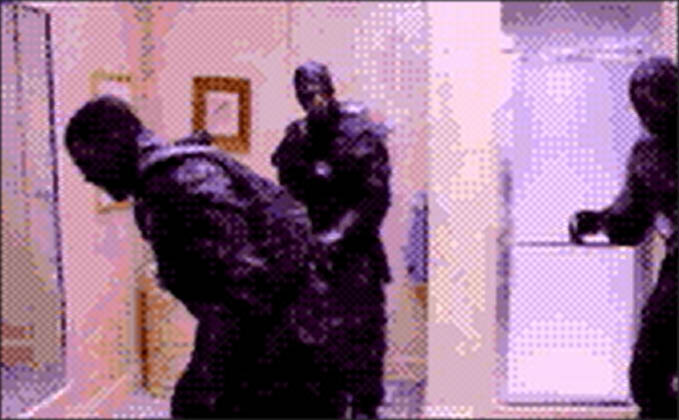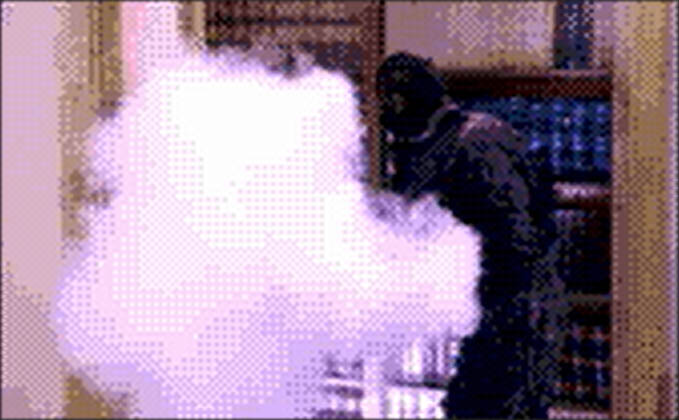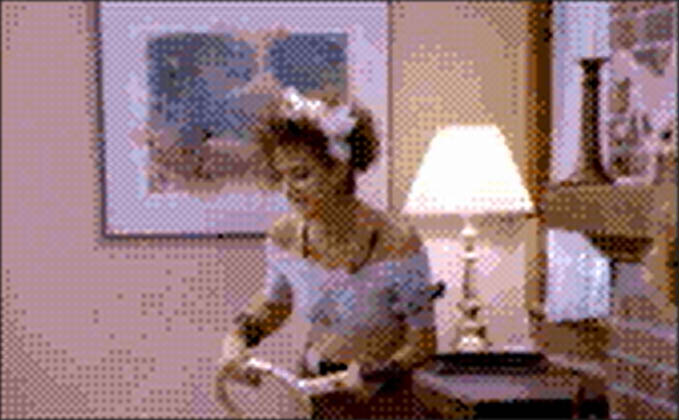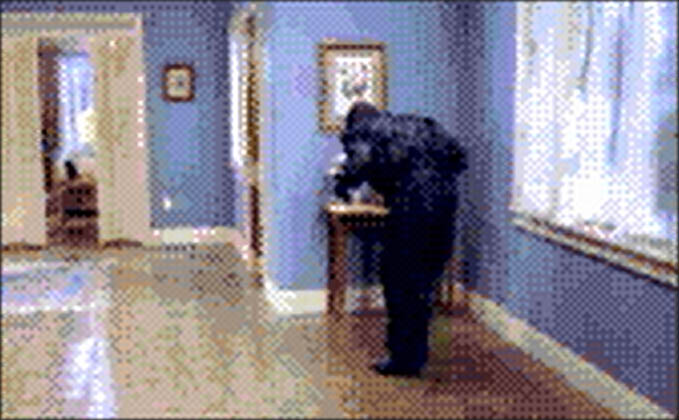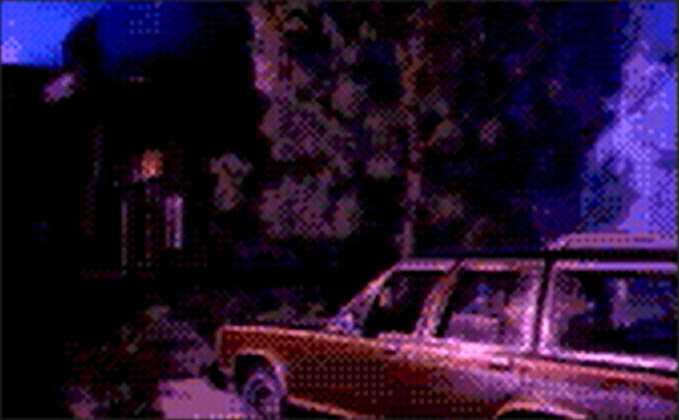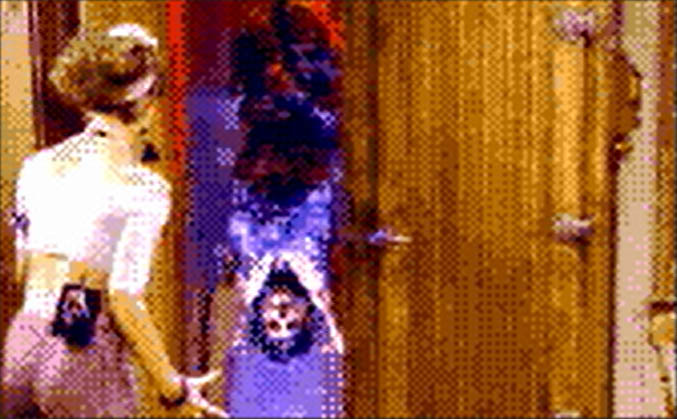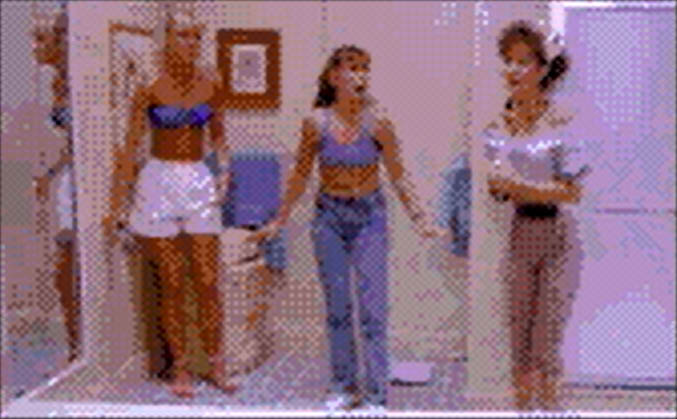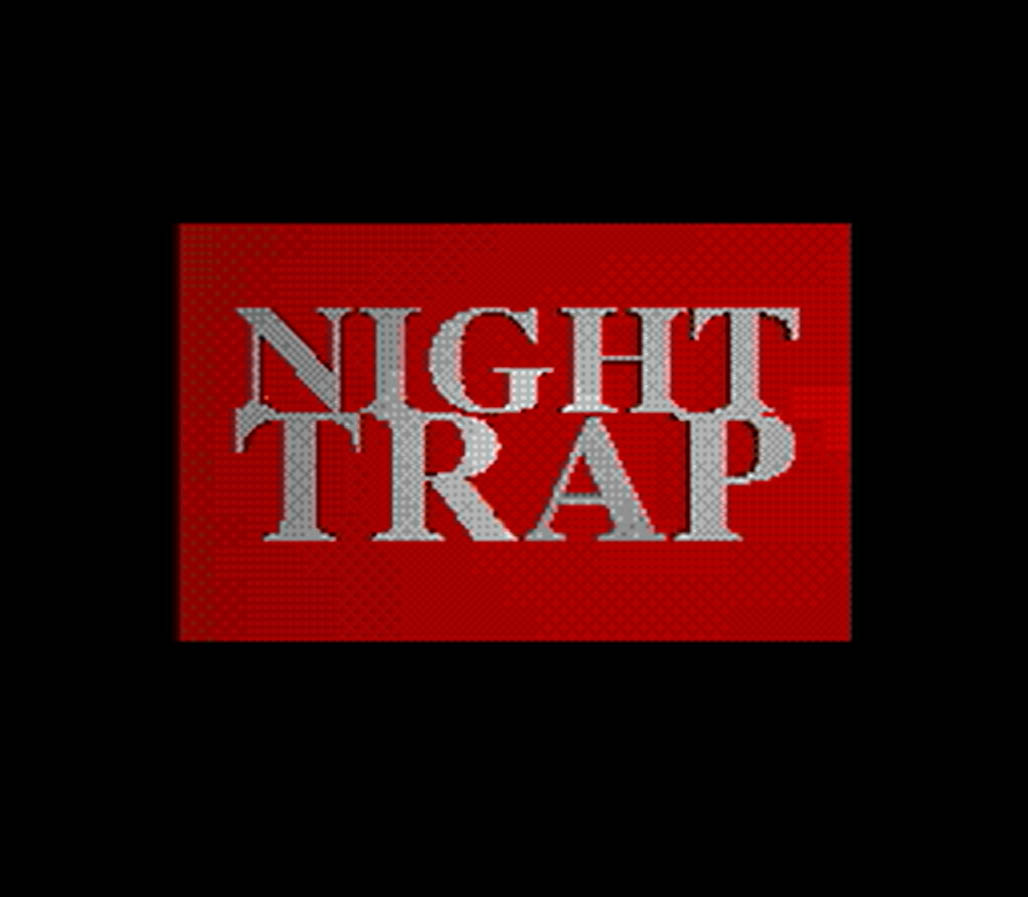

In 2017, Night Trap, one of video gaming's all-time most controversial games of all-time, got a remastered re-release to celebrate its 25 year anniversary. It went largely unnoticed. A quarter of a century earlier though, the total opposite was true. The original release of Night Trap, on Sega's Mega-CD (or Sega CD for those in the United States of Trump), was met with the type of frothy-mouthed outrage and disgust that your typical Daily Mail reader experiences on an almost daily basis. According to the “experts” of the time, Night Trap represented all that was wrong with the world. Its very existence would lead to the collapse of morality, and the end of human decency and respect for one another. It was obscene, depraved, vulgar, violent and sexually aggressive. Retailers whipped it off their shelves, the US Senate got their knickers in a twist about it, and a ratings system for video games was birthed from it. Up against modern standards, Night Trap is actually quite tame. In fact, even when it was originally released, it really wasn't the monstrosity that some people made it out to be. So, why did it garner such a reaction?
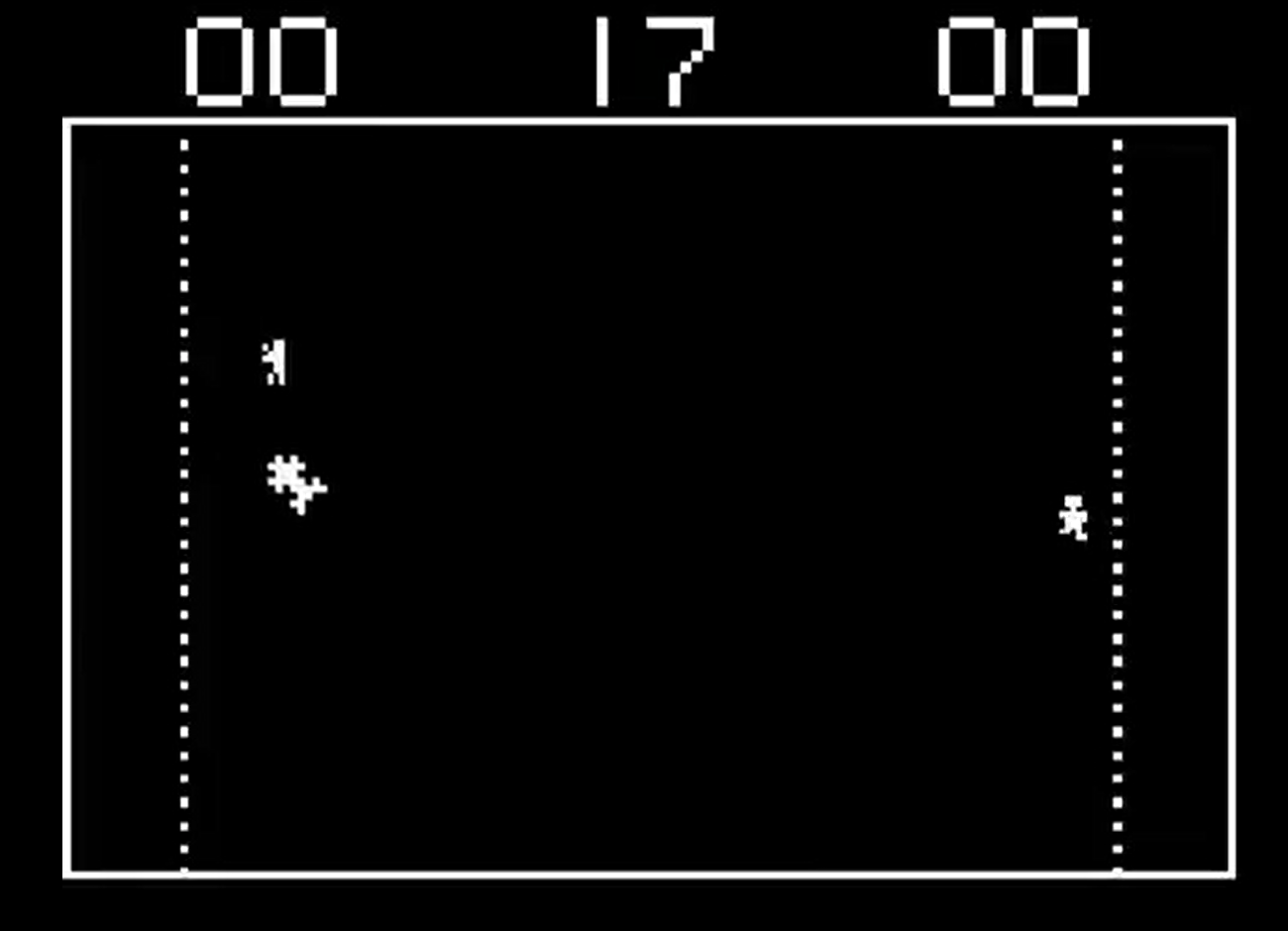
Let's take ourselves back in time to get a bit of context, all the way back to 1992. Now, even in the early nineties, violence and adult content in video games was nothing new. Gamers had been smacking the virtual crap out of opponents, slashing the pixels out of nasties, and decapitating sprites for years. And although concerns had been raised about video games being potentially harmful, most of the worries were about the effects of the activity of playing video games rather than the actual content of the games themselves. You see, although games did feature violence, and sometimes even sexual content, the relatively crude technology meant that things just didn't really appear violent or offensive. It's a bit like Tom and Jerry cartoons. The content in the cartoons was violent, but this violence could be masked by its cute, colourful and comedic appearance and effects. By the nineties though, technology had advanced to the point that graphics could become more and more detailed and realistic, and if you wanted them to, they could depict quite gruesome content. The advent of full motion video also meant that scenes in games could be played out by actors, rather than illustrated by graphics artists. Developers were also beginning to push the boundaries of what games could contain in an attempt to appeal to a more mature audience.

The early nineties was the era of Sega versus Nintendo. Mega Drive versus SNES. David versus Goliath. Or David versus David, as they were both pretty much equal. It was a golden age, a time that people look back on now with fondness and teary eyes. But back then it was war. Real war. The two companies ripped shreds out of each other. They fought for each and every gamer they could possibly get their mitts on. They caused friends to divide, families to fracture. You were either Sega or Nintendo. You had to pick a side. You couldn't be both. Or at least you couldn't admit it out of fear of being ostracised by everybody else you knew.
Just like today with the PlayStation and Xbox, as the market leaders of the time, both Sega and Nintendo's consoles would regularly see the same games released on them, although the technical differences between hardware back then meant that the games would often look and play differently, making the console wars much more interesting. Also just like today, each console had certain games that were exclusive to them, meaning that if you wanted to play a particular game, you had to get a particular console for it. Nintendo had a reputation of wanting to appear family-friendly while Sega aimed to come across as being more edgy. In a way, the children who grew up with the NES in the 1980s were the teenagers who wanted something more grown up in the 1990s. So Sega pitched their Mega Drive/Genesis, plus its CD-based add-on, to this older audience. The MTV Generation as some would call them.

Despite their family-friendly image, Nintendo were still quite happy to release violent games on their consoles - for instance, the aim of Street Fighter II on the SNES was simply to beat the crap out of your opponent, and for a while this game was exclusive to their console so they used it as a selling point for their 16-Bit super machine. However, they shied away from their games featuring bloodshed, as this apparently made the violence unacceptable. When Mortal Kombat became an arcade hit in 1992, it was licensed to appear on both Nintendo and Sega's consoles. The reality though was that Mortal Kombat wasn't a particularly great game, and the key reason for its success in the arcades was its bloody content and gory fatalities; the infamous finishing moves that saw your character end its opponent's life in graphic fashion. However, Nintendo requested that this content was censored for the SNES release whereas Sega were happy to retain it, albeit hidden behind a not-so-secret code (ABACABB if you're wondering). As a result, the Mega Drive/Genesis version of Mortal Kombat vastly outsold its SNES counterpart. But that didn't matter, because Nintendo of course had the moral high ground, as highlighted when the game was discussed in a Senate hearing on video game violence in 1993. Nintendo's representative, Howard Lincoln, stressed that Nintendo would rather sacrifice sales than have such filth in one of its games. He said To meet own game guidelines, we insisted that our largest licensee, Akklaim Entertainment remove the blood and death sequences present in the arcade version of Mortal Kombat before we would approve this game. We did this knowing that our competitor Sega would leave these scenes in and with full knowledge that we would make more money if we included the offensive material as well.
More likely they made the most of the opportunity in the hearing to be seen as the good guys and Sega the bad, as they didn't seem fussed about their own “guidelines” and potential lack of sales the year later when they permitted Mortal Kombat 2 to feature blood and fatalities.

Of course, Mortal Kombat wasn't the only game brought to the attention of the US Senate in 1993. Night Trap was another. An exclusive game released for the Mega-CD/Sega CD to demonstrate the awesome power of full motion video, the future of video gaming. Or FMV to give it is letterish name. It should have been called half motion video, seeing as the videos only ever really took up half the screen. But that would mean it would be HMV, and people would confuse it with a music shop. Anyway..... It seems that the Senator leading the hearing, Joseph Lieberman, had based his opinions on the game solely on its packaging and a couple of clips he'd probably seen in a TV advert for it. Still, it was enough to get him riled-up and angry, and he had a load of other riled-up angry people to back him up enough to the point that the game became the ultimate videogame nasty. Plus with Nintendo again claiming that such filth would never appear on one of their consoles, he seemingly had the backing of one of the industry's heavyweights. Although, as has been pointed out since then, apparently Nintendo passed on the offer to take the game only because they didn't have any consoles with the capabilities to run it. But, of course, they wouldn't be able to be all self-righteous if they mentioned that bit. And although you could argue that they have kept to their word and Night Trap has never appeared on any of their later consoles which would have been capable of running it, they have granted their famous seal of approval to games with much more graphic content in the 25 years that have gone between then and now.

As a freshly-turned 15 year old in 1993, I was eager to do some actual research into Night Trap. Unlike the so-called experts drafted in to denounce the game in the US Senate based on what they thought it was about, I decided to experience the game for real. Not at all because I believed it featured girls in their nighties at a sleepover in a house filled with hidden cameras. Oh no. A Mega-CD and Night Trap went straight to the top of my Christmas list that year as these would be the tools I'd need to conduct the research. And lo and behold, the Mr Claus delivered the goods on time and as requested. Who needs Amazon Prime when you have a jolly fellow in a red suit? And on Christmas morn 1993, the first thing I did after connecting up and switching on my Mega-CD was, er, not play Night Trap. Instead I put my Now 26 CD into it. Yes, Santa delivered that too, and I quite liked Meat Loaf's “I'd Do Anything for Love” song which was on it. But after I'd rocked out, Night Trap then took Now 26's place. And I was blown away.
Yes, seriously, I thought Night Trap was amazing. I simply couldn't believe that my little old Mega Drive now had the ability to play video, and feature real people acting out real scenes. With real music. Even then, I'm sure I realised that the video quality was terrible and the audio wasn't the crispest-sounding, But I really thought that home gaming had reached its technical peak. And of course, as a 15 year old teenager, I quite liked the idea that I had a video game which featured actual real girls in it. Yes, I was a sad lonely 15 year old teenager, and had to get my jollies by watching girls in grainy video; girls who don't even get their clothes off. All this media hype and outrage for nothing.

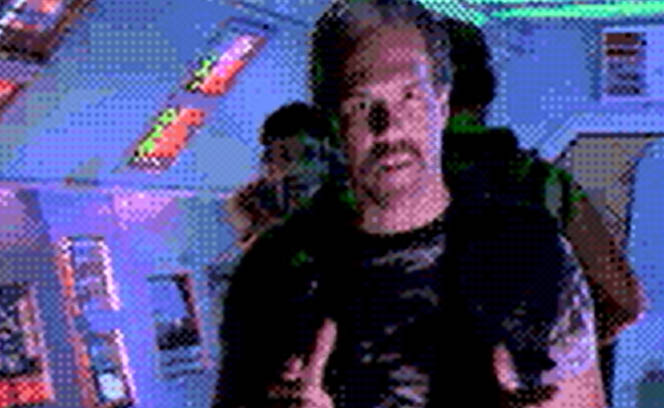
On starting the game, you are pretty much sent straight into the interactive movie. The title screen appears in rather dramatic fashion, a few credits pop up and we see some opening shots of a vehicle pulling up in a driveway and a house being spied on from a distance. Hiding away in a portacabin somewhere are the Sega Control Attack Team (SCAT) headed up by Commander Simms. Simms briefs you on the mission. And his briefing is roughly as thus.
Recently, five teenage girls have gone missing after visiting the home of the Martin family. Victor and Sheila Martin live in the old Lakeshore Winery house with their children Jeff and Sarah. SCAT appear to have got wind that another gaggle of five girls are also on their way to the house to spend the weekend. The game later reveals that they are Sarah's friends that she's lured in from the mall. One of the girls is Kelli, an undercover SCAT agent, who is going into the house to try to uncover from the inside just exactly what is going on. Quite how she befriended the other girls from the mall, I don't know. And why she didn't just warn them not to go, I don't know either. But, who needs logic if it gets in the way of a good story? Maybe Kelli is so undercover that nobody has noticed that they don't actually know who she is. Or they probably think she looks familiar (she's the girl from Diff'rent Strokes), so decide that they must know her from somewhere. The SCAT team have also discovered that the Martins' house has hidden cameras and booby traps set up all over it. They've managed to hack into the system controlling these cameras and traps, using a cable that they leave dangling on a wall in a hallway in clear view. And they've given control of the entire system to you. Your job is to keep an eye on the goings-on in the house, trap anyone or anything that could endanger the girls, but avoid trapping any of the girls themselves. Just to add even more complexities to an already over-complex mission, access to the traps is controlled with a code, set to one of six colours. You need to listen out for conversations regarding the code being changed so you don't lose control of the traps.


As part of his briefing, an increasingly angry Simms warns that if you don't have the guts or brains to carry out his mission, then you might as well give up right away. Now, of course I have respect for all people of authoritah, or those that wear uniform to make themselves look important, but Commander Simms is just a moron. He's the one hiding out in a portaloo somewhere, and although he knows that five girls have recently gone missing from the Martins' house, he seems only too happy to be allowing another five to go in there, including one of his own agents, without actually knowing what happened to the first batch. Not only that, he's trusting the supervision of eight hidden cameras and the entire network of traps to one person - you! And it seems that he's left recruitment of you so late that he's having to brief you on the whole mission, including how to operate the cameras and traps, while the action is already taking place. And what hi-tech gadget does he supply to operate this surveillance and trap system? A Mega Drive controller, that's what! Brewery and piss-up spring to mind. And you're questioning my guts and brains, Commander? What kind of Mickey Mouse operation are you running here? Your lack of planning for this mission is only exceeded by the lack of effort the US Senate put into researching this game.
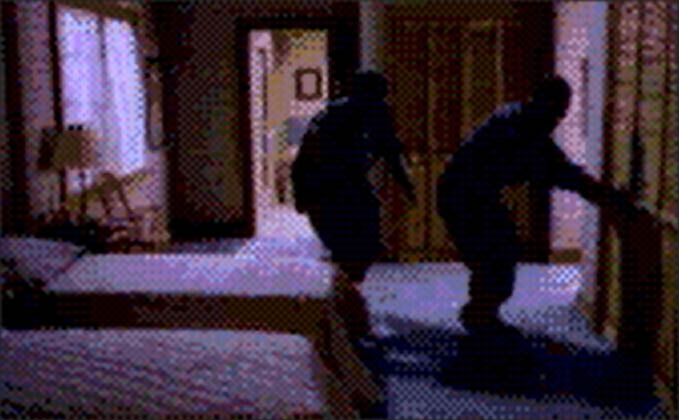
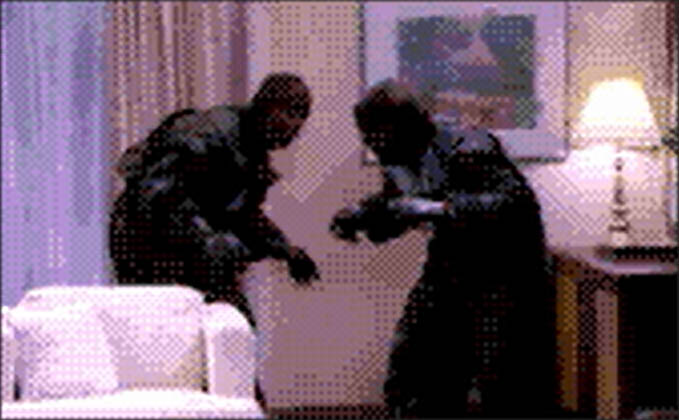
You quickly discover if you watch the intro all the way through that you're already two minutes into the game's action and have missed a number of the potential creatures that you can capture. Again, blame shit-for-brains Commander Simms for that and his piss poor management of the operation. He's setting you up for failure from the very start. The main aim of the game is to use the traps that you have control of to capture Augers, or Oggers, or Oggs. Yes, it seems that many of the characters in the game have difficulty in pronouncing what they actually are, so they tend to mumble something that vaguely sounds like one of the aforementioned words. They are basically people dressed in black bin bags and boiler suits. As the game reveals at some point, the clothing is to stop their skin from falling off, which is a rather unpleasant thought. The Augers need blood to survive, and as luck would have it, the Martins happen to be vampires. The family Martin also appear to be running some sort of operation where they bottle the blood of their victims, and seem to have an arrangement with the Augers whereby they provide them with some of samples of their produce. In return, the bloodthirsty Augers stay away from their home. Indeed, early in the game itself, it is explained that Victor and Sheila need to make a delivery to the Augers, so will have to leave their kids Sarah and Jeff, and their cousin Tony, to take care of the hapless house guests. However, as you will have already witnessed, and hopefully trapped, some of the Augers lurking around the house, you know that they haven't kept their part of the bargain. They're on the loose, and they pose a potential threat to the girls about to arrive, and also add confusion to the plot. In a way, your capturing of them is doing the Martins a favour. It always confused me when I was younger anyway. A bit like this paragraph. Maybe I'll rewrite it one day.


The girls arrive a couple of minutes into the game's action, and are greeted by Sarah Martin. Sarah then introduces the girls to her creepy and kooky ma and pa. There is Cindy, the tall blonde one, Ashley, the shorter dark-haired one, Megan, the “I'm so crazy” annoying wacky one, Lisa, the stuck-up one, and Danny, Lisa's brother, who isn't actually a girl. And then there is of course Kelli, who has to introduce herself because Sarah doesn't know who she is. And Sarah doesn't get a bit suspicious? And then the fun begins. You have to split yourself between catching Augers and keeping an eye on the plot. OK, you don't really need to keep too close an eye on the plot, but it's probably useful as it helps to make the game a bit more entertaining. And you do need to listen out for certain moments when family members discuss needing to change the access code to the traps. If you miss it, and don't change the code accordingly, you won't be able to operate the traps. And as the codes changes tend to happen shortly before a few important captures are needed, you do need to make sure you know when and where these changes are announced. Of course, you can attempt to guess the code as it is just a case of picking the right colour out of six, but it's not the best way of playing the game.

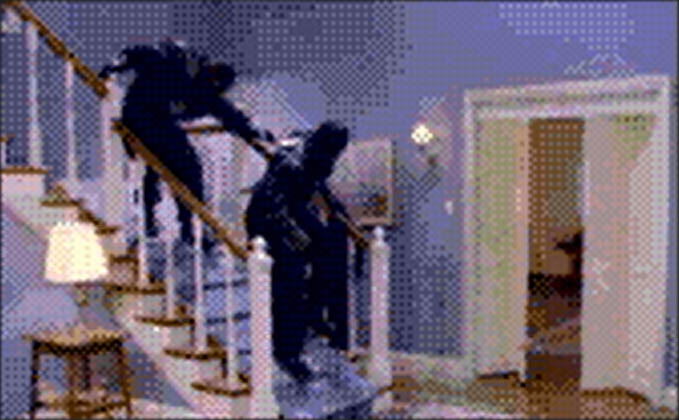
You don't need to capture every Auger. Just enough to keep Commander Simms happy. Let too many go free, and he gets angry. So angry in fact that he stops the movie, gives you a telling off and rips the cord out of the back of his Mega Drive controller, cutting you off completely. Why couldn't he just take the controller out of its port or use the Mega Drive power switch or the reset button like most people do when rage quitting? And why would he do such a thing anyway? The jerk. Not only has he prevented the possibility of capturing any of the other Augers or saving the lives of the girls, he's also broken the only device he has to operate the cameras and traps. And who's going to do the job now? And with what? He'll probably need to spend another five minutes having to brief your replacement on what's going on anyway, by which time the entire house will probably be a bloodbath. I bet after his mismanagement of the Sega Control Attack Team and this entire operation, Sega then put Simms in charge of the release of the 32X and Saturn. It'll explain a lot anyway.

Even if you have missed a few Augers, but not enough to cause Simms to prematurely pull the plug on you, there are some that you simply can't miss. These are the ones that are attempting to capture your girls. The first girl to save is Lisa, featuring in the infamous bathroom scene that got everybody hot and bothered once upon a time. In this scene, an Auger is hiding in the shower cubicle as Lisa, dressed in her night clothes, freshens up in front of the mirror. Noticing the Auger, Lisa initially thinks that it is Megan so isn't particularly frightened. But another two Augers appear from a side-door and begin surrounding Lisa, one with a strange-looking contraption. Fail to activate the trap at the right time, and the Auger with the contraption puts it around Lisa's neck and begins extracting blood from her. Lisa screams in terror and is dragged off the badly constructed set through the side door. And you'll have just witnessed the scene that will now turn you into a deranged psychopath. This of course will anger Commander Simms, and his idiotic face will pop up. He'll berate you for your incompetence and remove the cord from his Mega Drive controller. Once again leaving the rest of the girls to suffer whatever misfortune will now befall them. And with another broken controller. Of course, save Lisa and she'll escape from the house, leaving you to continue with your mission.
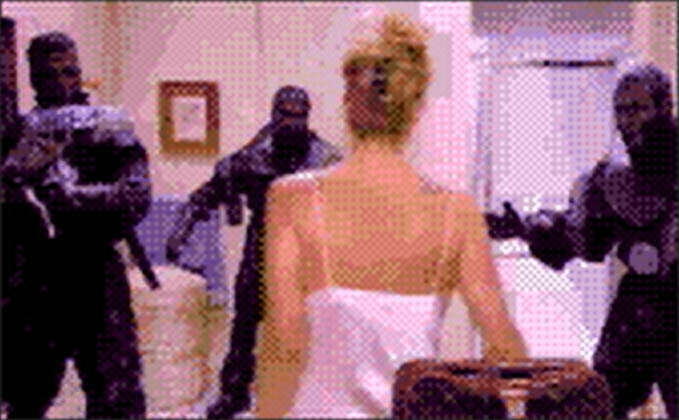

The game continues as such, with most of the rest of the game requiring you to prevent the remaining house guests from being captured. Unlike the first half of the game, which sees you missing a lot of the actual story content as you attempt to trap Augers in other parts of the house, the second half sees you needing to follow the girls as they go screaming around the house so you can be there when they fall into danger. Even so, there are still Augers creeping around in other areas, so you do still need to excuse yourself from the main plot every now and again. At several points throughout the game, SCAT agents enter or attempt to enter the house, including twat-head Commander Simms himself, but they prove themselves to be next-to-useless and provide no assistance whatsoever. If you successfully save all of the girls from the Augers and the Martins, you complete the game. Easy peasy!
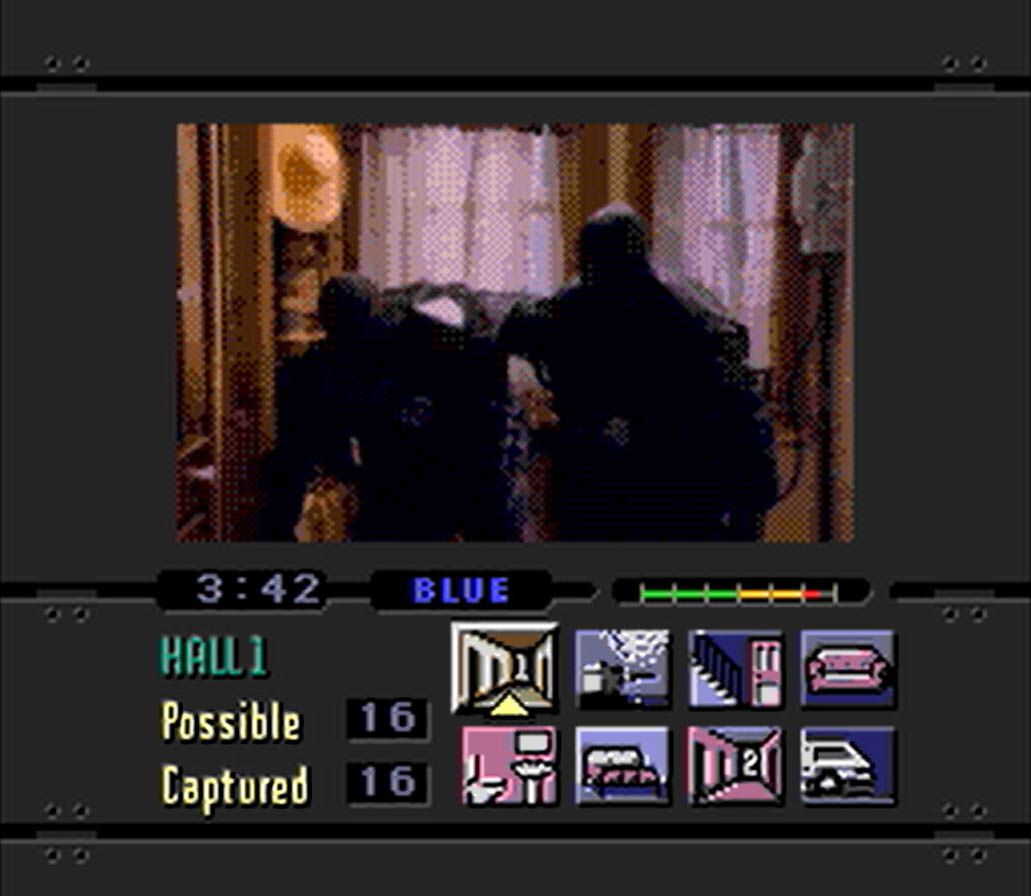
The controls for the game are simple. You can choose a room by using the d-pad and A button to select it. An on-screen meter flickers depending on the level of activity and the proximity that a character is to one of the traps in the room. Most of the time it's green. It raises to yellow if somebody gets close to a trap, and goes to red if they are on it. Once the meter hits red, you can give your B button a firm whack to activate the trap, and watch in delight and glee as you capture your prey. Of course, sometimes you don't want to trap a particular character so you can ignore the trigger, and the game offers up some cheap tricks where you need to wait until the meter hits red a second time to make a successful capture, including at one key moment. Mess that one up and it's game over. The C button is used to change the access code to operate the traps. Also on screen is the time, the number of captures that have been possible and the number that have been successful. Each time you miss the moment of a possible capture, you'll hear a beep. And this might be your trigger to grab a piece of paper and a pen, and then to note down the time you heard the beep. This is because the timings and locations of the captures are identical each time you play the game. But finding out where they are is initially a case of trial and error. As the game ends when you've let too many Augers go free, or let one of the girls you're meant to be protecting get captured, you have to start again. And each time you play it, you'll try different rooms to see what happens in that one. This does have the effect that it won't be too long for you to memorise quite a bit of the early sequences in the game and know exactly where to go and when. From memory, the first ten captures can be completed in the following sequence - Hallway 1, Living room, Bedroom, Bathroom, Bathroom, Living Room, Kitchen, Entryway. It'd probably make an interesting subject of research, observing somebody playing this game for a day and seeing how they go about acquiring the knowledge and memories required to get through the game, and what visual and sound triggers are used to jog the memory. The game is certainly possible to complete with memory alone, and as you'd need several attempts to work out what happens where and when, you'll also witness most of the actual storyline unfold as part of your trial and error exploration of the house. But if you're going for a perfect playthrough, and you don't want to have to rely on memory, you will need a list of times and places for captures noted down. For the best experience, it's best to put this together yourself. Just grabbing one from the internet will just result in you going straight for the captures as listed and not really experiencing the movie.



Yes, the movie. It's, um, well, good in a so-bad-it's-good kind of way. It's about as eighties as you can get. This isn't deliberate. Although the game was first released in 1992, it was actually filmed in 1987 for the Control-Vision, a VHS-based console from Hasbro which also went under the codename NEMO. The console's launch was scrapped, and the footage for Night Trap, and fellow FMV title Sewer Shark, were put into storage. However, the compact disc format seemed to suit the concept behind the games that were in development for the Control-Vision, and the recordings for Night Trap and Sewer Shark were dusted off and slapped onto CDs as flagship titles for the Mega-CD/Sega CD, demonstrating things that couldn't be done on non-CD based consoles. Adding a bit of star value to the game is Dana Plato, who played Kimberly Drummond in comedy series Diff'rent Strokes. In Night Trap she is undercover agent Kelli. Several of the other actors featured in the game have appeared in a few US TV shows, mainly soaps and police dramas. All of them ham it up for Night Trap, giving performances that make it more of a parody of the teen vampire genre rather than being a serious piece of drama. At least I hope it's parody. Production standards do seem to be low, with sound quality dipping every now and again, obvious speeding up of the film in certain parts, and visible jumps when a trap is activated and the game has to cut the footage of the character getting trapped rather than escaping. The low standard of production feels kind of deliberate, again as if it is reflecting the idea of the game being a parody of teen horror films. In a strange way, the movie actually suits its grainy appearance on the Mega-CD.
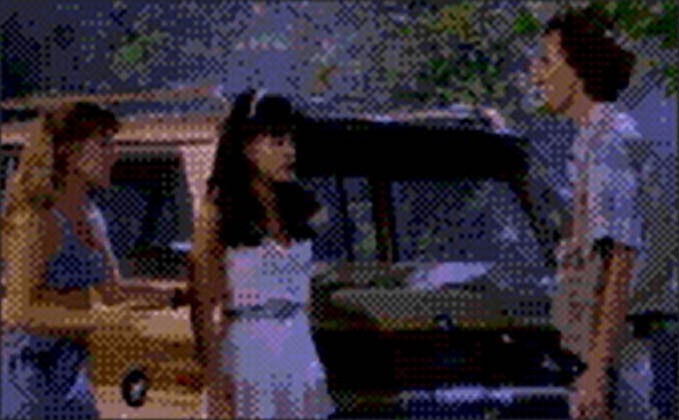

The running time of the game from start to finish is around 25 minutes, so it's all over fairly quickly. There is apparently over an hour's worth of footage contained within the game though. This is because there are several moments when simultaneous events are happening in different rooms. An example early in the game is when the girls arrive. The Martins are talking about the plans for the evening in the kitchen, while the girls are arriving in the driveway, and at one point Sarah walks through the entryway to announce their arrival. You can flick to any area to see what's going on, but obviously can't watch all at the same time.
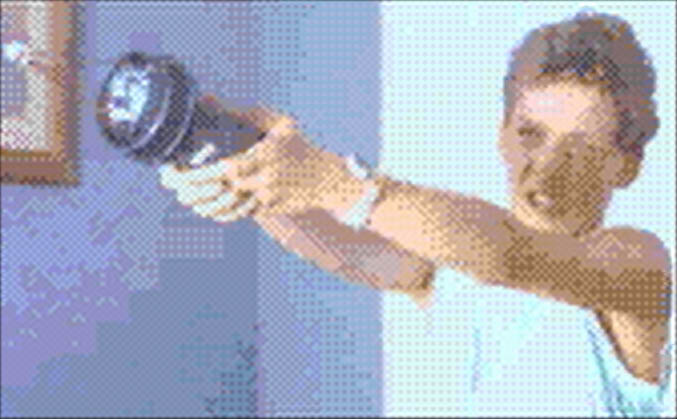

The problem that FMV games had, and the main reason why the genre was quite short-lived, is that they were quite limited in actual gameplay. Although marketed as interactive movies, they weren't really that interactive. In effect, they were simply a video that required you to press a button when prompted, which then had the consequence of continuing the video, or cutting to another scene which would usually end it. Games like Road Avenger, Cobra Command, Time Gal, Sewer Shark were all at it. They were really just a series of quick time events, the bane of many modern games. Night Trap was similar, although it had the added feature that it had multiple simultaneous streams with you needing to choose which one to watch. But the principle was still the same - to keep the video going by pressing the right buttons at the right times. For FMV games to work and to compensate for the relative lack of interactivity, the video in them needed to entertain. Fortunately, Night Trap succeeds in this area. It isn't particularly dramatic or thrilling, and it's not remotely scary, but as it squeezes in quite a lot of action in a short timeframe, there's no real let up in its goings-on. It's cheesy, comical and camp. Seen as a whole, it really isn't the horrific, depraved, violent game that it was made out to be. It does feel fun to play, although the whole trial and error aspect might be frustrating for some. There's nothing worse than getting into a room just after missing a couple of captures or suddenly finding your traps no longer work because the one of the Martin clan has decided to change the access code. Additionally, once you've played it through and seen everything there is to see, it'll probably be a while before you go back to it. And when you do so, you'll either have to re-learn and/or remap the sequence of events or dig out your old notes and follow them. And of course, allow yourself to be tarnished once more by exposing yourself to such disgusting footage.


It feels strange to think now that 1992/1993 was still fairly early on in the history of home gaming. If we take its birth as being the late 1970s, by 1993 it was only about 15 years old. It's now around the big 40. And seemingly in 1993, it was going through its difficult teenage years. It was rebelling and experimenting with new things that older generations didn't understand and therefore didn't like. Although it did seem to me at the time that mountains were being made out of molehills when it came the issues that were raised about the content in games such as Mortal Kombat and Night Trap, looking back I think that the people raising them did have some valid points. I think what discredited their concerns was the fact that they raised them with a complete ignorance of the industry that they were attacking.

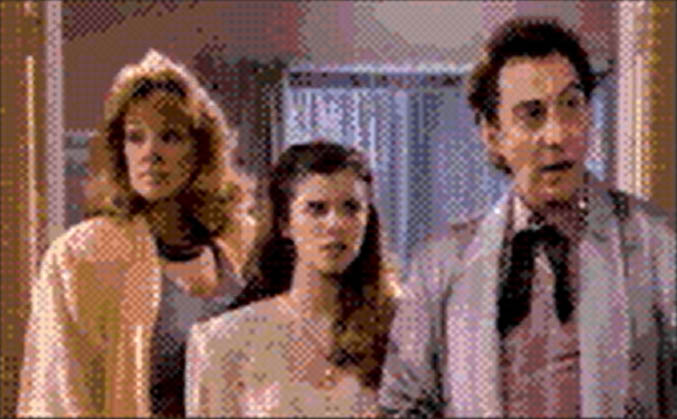
A problem with the gaming industry back then was that it was expected to be self-regulating. In other words, game developers, publishers and console manufacturers had the moral responsibility of ensuring that games were suitable for their audiences. Ultimately the decision about what games could be released on consoles and what content they could contain usually came down to the console manufacturers, who had the final say on what games they would license. Sega and Nintendo could choose to censor games (and they did do this - the old Mega Drive game Mystic Defender contained full-on pixelated nudity in the Japanese version, whereas the Western release didn't). But they could also choose to permit, and even encourage, certain content. And by permitting the blood and fatalities in Mortal Kombat, and releasing Night Trap, Sega were seen to be pushing the boundaries of general acceptability a little too far. And this is where the US Senate got involved, dragging Sega into the congressional ding dong mentioned right at the beginning of this entry (remember?) towards the end of 1993.
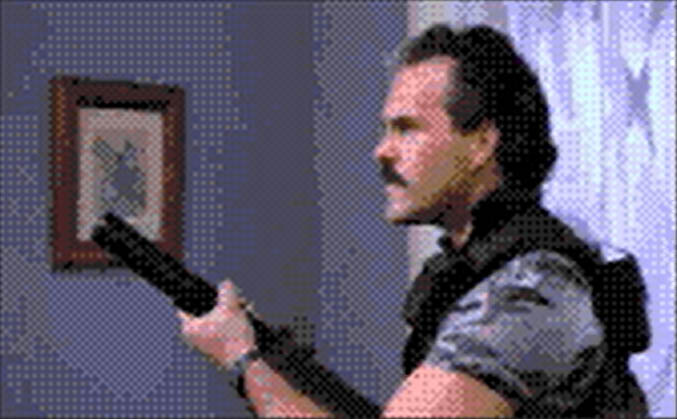
Watching footage from the hearing is cringeworthy in parts. Although it wasn't a court case, it still felt like one. Sega were the party trying to prove their innocence, with Senator Joseph Lieberman drafting in a bunch of witnesses for the prosecution whose evidence was mostly based on opinion and their own agenda rather than anything actually factual. Their main complaint was that while games like Mortal Kombat and Night Trap contained content deemed unsuitable for children, Sega weren't doing enough to prevent them from landing in the hands of them. Some at the hearing thought that Night Trap was unsuitable for everyone. A completely neutral and unbiased lady from the National Coalition of Television Violence was appalled by the game and claimed that nobody would want their teenage daughter dating somebody who had just spent three hours watching or playing Night Trap. Maybe that's why I could never get a girlfriend. Somebody blabbed to them. For much of the hearing, the experts deriding the game seemed to be of the opinion that the aim of it was to trap and murder innocent girls. The very fact that it was obvious that nobody complaining about the game had actually played it nullifies many of the potentially valid points they had about it.
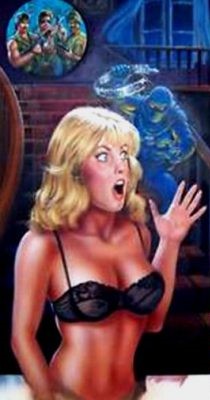
Sega's argument was that the highlighted games weren't actually designed for children. They had done their research and were able to provide all kinds of graphs and charts and statistics to demonstrate the demographics of their customer base, and had discovered that gamers were getting older and wanted games to suit their interests. In the way they marketed Night Trap, it seems that Sega were appealing to the carnal desires of their mostly teenage male audience. There's no denying the fact that Night Trap was promoted by the fact that it featured attractive girls staying in a house with hidden cameras. Even the instruction manual states that five (5) more house-guests, all unattached, beautiful females between the ages of 16 and 19,
are going to be in the house. It was basically inviting you to be a perv. And I do recall that any marketing of the game usually featured a screenshot of the bathroom scene featuring Lisa in a silk white nightie, in an obvious attempt to suggest that the game featured some titillating content. Again, this was something that was picked up at the time. It wasn't just that games were violent. The depiction and perception of women in Night Trap was also sexist. However, you could say that by constantly depicting Princess Peach getting kidnapped and needing to be rescued by Mushroom Kingdom's local plumber, Nintendo weren't portraying female characters in games positively. In fact, in Night Trap, it really is only the female characters that have something about them. All of the male characters are basically buffoons.
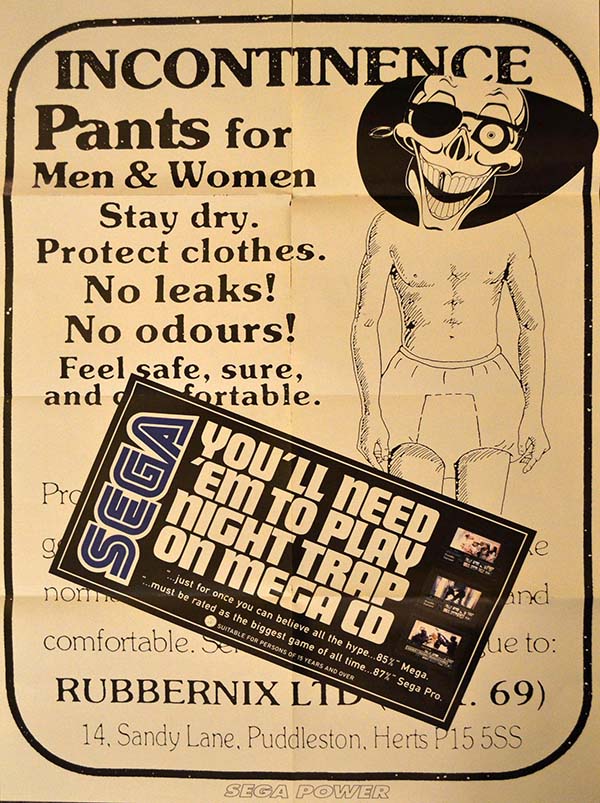

Part of Sega's problem was that, despite the fact that they were allowing games to be released for a more mature audience and promoting them accordingly, video games were still seen as toys. Unlike today when consoles are regularly found plugged into a home's main TV set, back in the early 1990s, they still hadn't really made the move out of the bedrooms of children. And much of the hearing in Senate and general hullabaloo alongside in it in the media centred around how the video gaming industry wasn't thinking about the children. As such the role of toys in childhood was something that cropped up. Toys were meant to be tools to prepare children for the wider world, to educate them. Mortal Kombat and Night Trap did neither. Arguably, you could say that Night Trap improves one's memory, and Mortal Kombat tests dexterity, hand-to-eye coordination, and basic combat/self-defence skills, but it's not a particularly strong argument. Surely another purpose of toys is purely for them to be entertaining as this is key for children wanting to interact with them. And older children want to be entertained in different ways than younger children. So "toys" like video game consoles can do this by tailoring their games for their different audiences. Just like books, magazines, television programmes and films. And, like it or not, horror, as sort of featured in Night Trap, is as legitimate a form of entertainment as other genres. Night Trap isn't actually that far removed from the more recent Twilight series of books, in that they all try to provide teenage kids with a taste of mostly harmless horror.
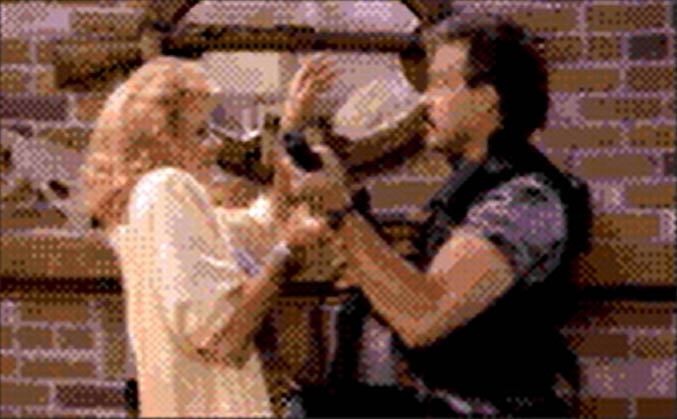
In an effort to ensure that games were labelled to show which ones were designed for which audiences, Sega had introduced the Videogame Rating Council in America. This was their own age rating system for video games. The ratings weren't enforceable and if anything, made certain games more desirable. But it gave parents an idea of which games may or may not be suitable for their little darlings. You know, like trying to put the onus on the parents to take some responsibility in what they allow their children to play. Also, it had only been launched in the summer of 1993, months after the US release of Night Trap, and was seen as being a reaction to the outcry about the game's content, and to preempt the inevitable controversy for the pending release of Mortal Kombat. Similarly, here in the UK, where similar concerns were also being raised, Sega voluntarily submitted Night Trap to be certificated by the British Board of Film Classification (BBFC) to get it rated as if it were a movie. Here it was awarded a 15 certificate, which made it illegal to be purchased by or for somebody under the age of 15. Was this a fair rating or was it given just to appease public outrage? It's a difficult one. On the one hand, the violence in Night Trap is hardly graphic, the horror isn't remotely terrifying, and, despite suggestions in its marketing, there's nothing much in the game to arouse or excite the nether regions. The content is no more scary than an episode of Doctor Who, and film series like Pirates of the Caribbean or Harry Potter feature more disturbing imagery. That said, I wouldn't want my son or daughter playing such a game until they were at least a teenager. A PG rating might have been fairer given the actual content, but I guess interactive movies were new ground for the BBFC, and they may have had to factor in that the player has some sort of influence in the game's goings-on, so this might have more of an effect on them rather than just the passive activity of watching a film. But more than likely they felt they had to give it a 15 rating or face all kind of flak and criticism.
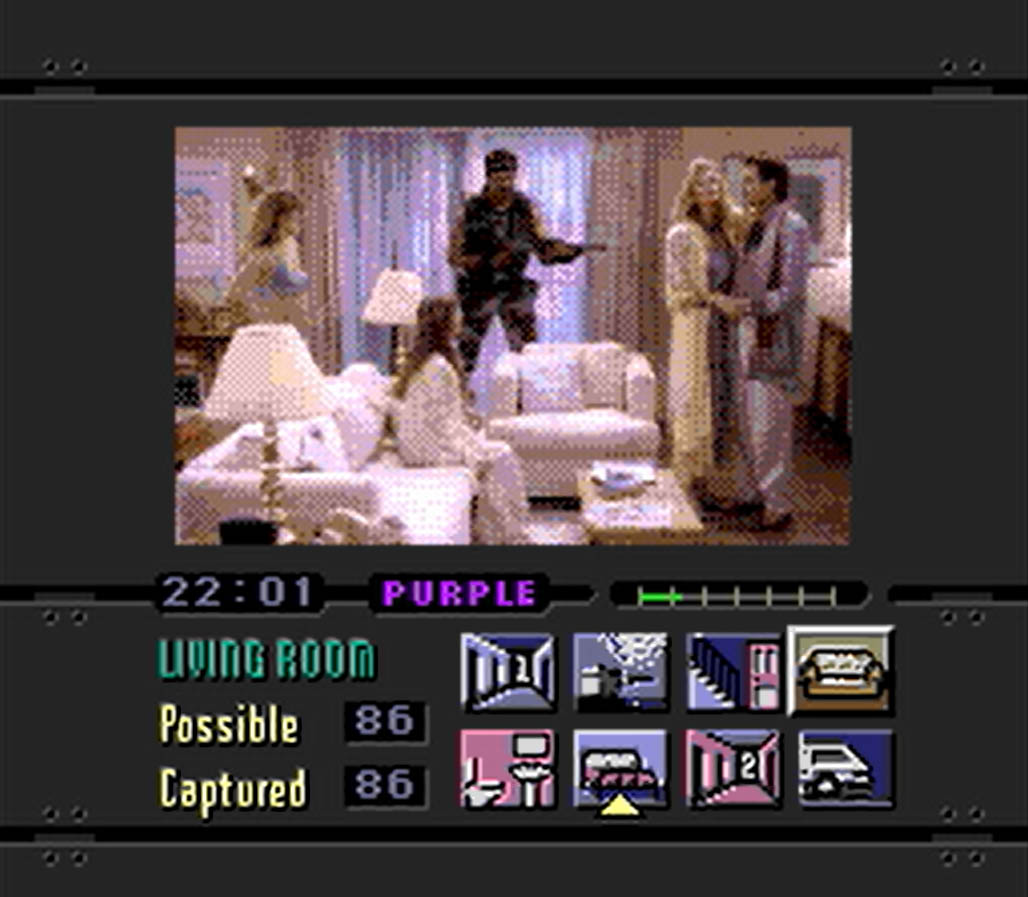
Although it seems like a lot of what Sega were doing was reactionary, they were at least trying to do something to enable games developers and publishers to put out games that could be made for a specific audience or demographic. Technology was improving, gaming had moved on and it was becoming a mainstream form of entertainment. And it wasn't just a form of entertainment for children. Why couldn't adults enjoy video games? Sega had the reputation of being more liberal than their main competitor in allowing certain content on their consoles, a move that was leading to the industry growing up. Arguably, Nintendo with their holier-than-thou approach were holding it back, trying to preserve gaming as a hobby for children. Or more than likely simply trying to score points over their arch-enemy without actually thinking of the games industry itself. That said, in a December 1993 interview for Electronic Games magazine about video game ethics, a spokesman for Nintendo seemed to confirm that the company weren't too aware about of increasing age of gamers. He said Our business is still kids sub 14 years of age. Some players have grown past us and are now 16, 18, or even 20, but they were replaced by another 3 or 4 million kids in the U.S. and 10 or 15 million kids around the world whom we believe are today's and tomorrow's heavy consumers of this kind of product.
So who knows? Maybe Nintendo genuinely didn't believe that there was a market for games for older gamers. Even 20 year olds were still playing games for heaven's sake! Surely they should be doing other things, like finding proper employment, getting married, raising a family? Anything but playing video games! The reality was that games like Mortal Kombat and Night Trap were just a sign of things to come. Developers, publishers and gamers wanted their industry to be taken seriously, to be seen as something that wasn't just for children. And in a way, despite the ignorance shown by the non-gaming media and governments at the time, by raising the semi-valid concerns that they had and putting the spotlight on video games, they actually helped to legitimise gaming as an activity that could be enjoyed by anyone. They weren't necessarily wanting to stop the gaming industry from growing and expanding to appeal to a wider more general audience. They just wanted to ensure it happened correctly, and to ensure that children, quite rightly, aren't exposed to content that could be upsetting or inapproriate to them.
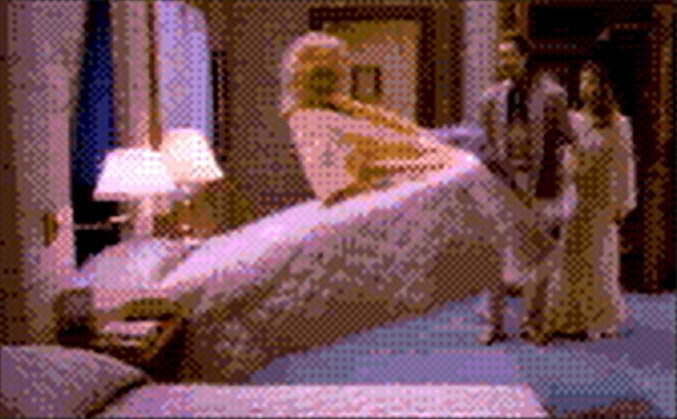
I suppose what angered gamers back then, and still angers me today, is the way that video gaming was misunderstood, misrepresented and demonised. In 1993, we were in a situation where people who didn't play video games came up with all kinds of reasons why they were bad. And the US Senate hearing, overseen by people who make laws that affect large parts of the population highlights this to great effect. There were just so many flaws in the arguments and outright lies put forward by Lieberman and his obviously-biased cronies, that Sega should have asked for the case to be dismissed based on pure incompetence on the part of the prosecution, not that I'm even sure if that's a thing. It really was fake news defined, a quarter of a century before it became a term. From Lieberman simply lying about Night Trap being based in a soriety house, to a Professor of something seeing examples of fascism in the game (Simms apparently reminded him of a Nazi. I know he's an ass, but he's not quite that bad), and homophobia and racism in other games, with racism being due to the fact that many games of the time featured ninjas. Pretty much all of their arguments were flimsier than a copy of TV Quick. Or something else flimsy. And it's a shame as they did actually have a genuine case. Undeniably, video games were getting more violent and technology was advancing so quickly that games were able to portray this in increasingly realistic and graphic ways, and video game publishers and console manufacturers didn't really have a universal way of regulating such a thing, partly because they had their own opinions on how such things should be regulated, and partly because they were in fierce competition with each other, so whatever idea one would come up with, the other would simply oppose. That said, the vast majority of games released on both Nintendo and Sega's consoles were still very very family friendly, and it really was a small minority of games that were anything other. I think that both companies did take their role of guardians of decency in video games very seriously, and did whatever they thought was right when deciding what games could and couldn't appear on their consoles, while addressing the needs and wants of their maturing customer base. It's just that they seemed to refuse to unite to do so in a uniform way.

Even so, the main outcome of the Senate hearings was the ruling that either the video game companies (developers, publishers, and hardware manufacturers) had to come up with a way of regulating themselves, or Government would do it for them. Gaming companies came up with the Entertainment Software Rating Board (ESRB) in the USA which would provide age ratings and classifications for all video games released in America and nearby countries. It wasn't all that different to Sega's Videogame Rating Council, but different enough so that Nintendo would accept it. Founded in 1994, it is the system still used today to provide certifications and classifications for video games on all platforms. Ironically it permits games nowadays to contain all kinds of violence, sex, drug references, blue language and nudity. And of course, even "family-friendly" Nintendo allow such games to be released for their consoles. Hypocrites! Similar systems were implemented in Europe before eventually being combined into PEGI (Pan European Game Information) from 2003. In some countries, including the UK, the age restrictions on PEGI-rated games are legally enforceable. Even with age ratings and restrictions, discussions do regularly crop up regarding violence in video games, with many people still holding onto the belief that participating in ultra-violent interactive experiences can't be good for some people. All too regularly today we hear of mass shootings in schools in North America, and quite often the description of the gunman includes details of how he happens to be into violent video games, as if they're to blame for his lunacy. I think the fact that he was able to get his hands on a gun as easily as his hands on a violent video game is perhaps more of the problem. But, for some reason, the US Senate don't seem to want to discuss that, There's also the argument that some content in games is unnecessarily graphic and is included just because it can be. But those are discussions for another day because it's late and I've typed enough now.


So, that's Night Trap. Well, Night Trap and lots of other stuff which had something to do with it. On its own, it was a novel and technically clever game, showcasing some of what the Mega-CD/Sega CD could do. It was fairly fun, very much of its time, and would probably have been left there if it wasn't for the attention it, perhaps undeservedly, received. It symbolised the changing world of video gaming, playing a key part in enabling the industry to grow up, for it to appeal to a wider, more general audience and for it to take its responsibilities towards this audience more seriously. It showed the fierce rivalry between Sega and Nintendo, that government really don't have a clue sometimes about the laws that they try to make, and that people who claim to be experts quite often are none of the sort. And, despite getting banned in some places for a period of time, I'm sure the publicity it received helped Night Trap to sell more copies than it probably should have. The US Sega CD version of Night Trap was withdrawn in early 1994, shortly after the Senate hearings, and an apparently censored version was re-released in 1995, although I'm not too sure what was actually censored. The only difference appears to be the opening sequence. In Europe, the original version was released in 1993 and remained on sale for however long Mega-CD games remained on sale. Apart from in Germany where it didn't get released at all. The game went on to receive ports to other consoles, such as the Sega 32X (using the Mega-CD/Sega CD), 3DO, Mac and PC. And, of course, in 2017 it received a re-release to mark its 25th Anniversary. The re-release, featuring remastered footage of the original content and lots of extra stuff about its original release, was released on PC and PS4. Well, on PS4 in certain regions. It's still not available in Europe and sadly, I don't think this bothers too many people.
I haven't actually played the re-release yet. I hope to do so as I did actually really enjoy Night Trap. Revisiting it and playing it through (over and over again) for this entry did bring back some happy memories; memories of Megan miming badly to the Night Trap theme tune, Victor Martin over-acting his way through his lines, Cindy accidentally eating a blood popsicle, and having to note down times and locations kept me amused for several evenings. It's relatively fun on its own as a game, but for anybody interested in the story of video gaming and how we ended up where we are today, it's a key title in that story. I'm sure anybody playing it for the first time today will wonder what kind of people we were 25 years ago to find such a game offensive and controversial. But I suppose that's one of the reasons why it still needs to be played. It's a piece of history.

Less than two weeks after publishing this entry, Screaming Villains announced that the remastered version of Night Trap will be getting released on Nintendo's Switch console.....
MEGA-CD GAMES GAMES RELEASED IN 1992 MEGA DRIVE GAMES"There really isn't a massive amount of game here. It's just a case of writing down the times and places and going through them, which really isn't much fun."
Electronic Gaming Monthly (USA, December 1992): 5 (out of 10)
"Night Trap is the type of title that makes me ask WHY? several times throughout the game. The digitized pictures are decent, but the plot needs some work. After playing for about five minutes, you will quickly lose interest in this one! Still, this is the cutting edge of technology, so accept some glitches here and there."
Sega Power (UK, September 1992): 4 stars (out of 5)
"Some scenes are unsuitable for young children but its not as gory as everyone makes out. What it is, however, is a damn fine game. Excellent stuff."
Mean Machines Sega (UK, April 1993): 89%
"Definitely the most advanced and innovative Mega-CD game seen yet. It's not everybody's cup of tea but if you enjoy a challenge and have good reflexes t'll make a great party piece."
Sega Force (UK, June 1993) 84%
"Night Trap's a treat to look at and holds your attention as you trap monsters and try to look down the front of the girls' blouses!"
"Great graphics and sound. You're now part of a game. Lap it up! A great buy"


